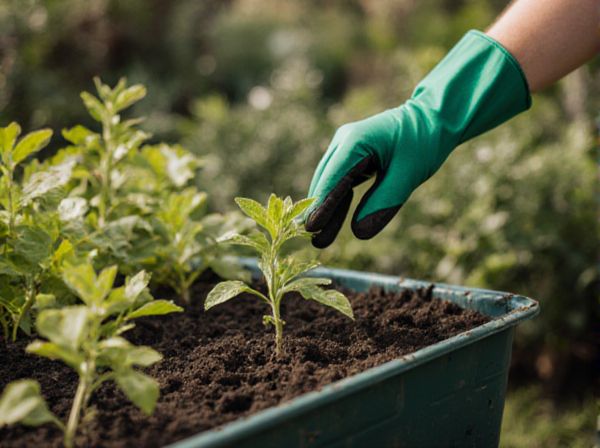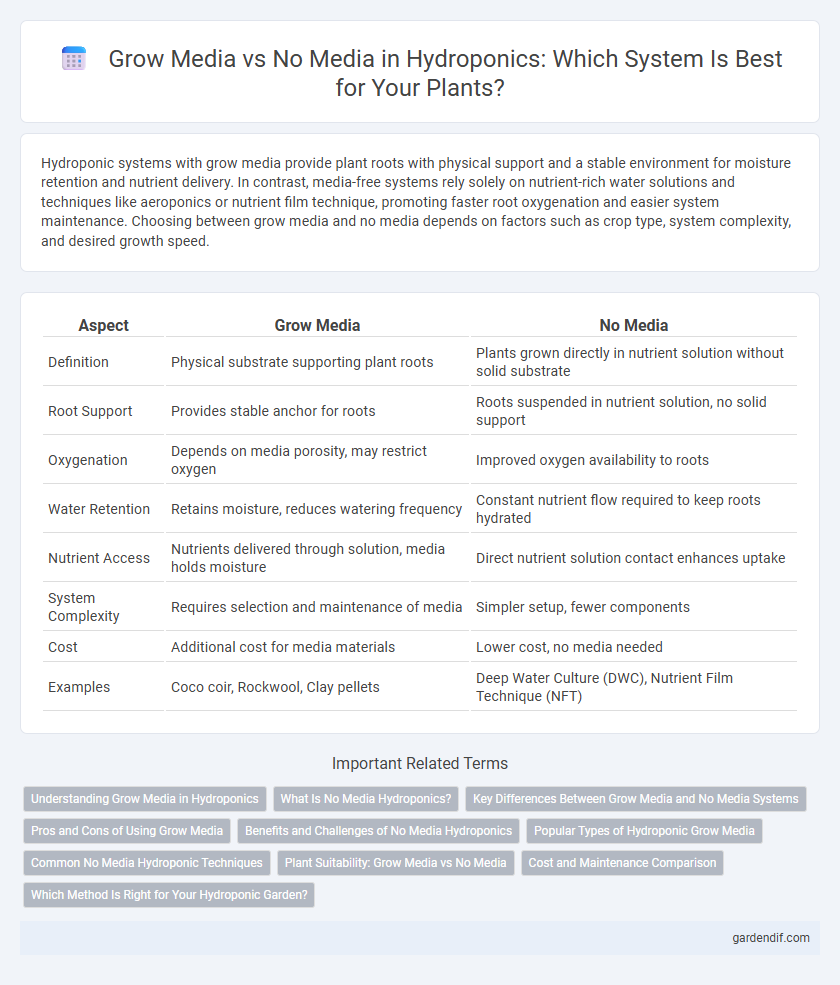
Grow Media vs No Media Illustration
Hydroponic systems with grow media provide plant roots with physical support and a stable environment for moisture retention and nutrient delivery. In contrast, media-free systems rely solely on nutrient-rich water solutions and techniques like aeroponics or nutrient film technique, promoting faster root oxygenation and easier system maintenance. Choosing between grow media and no media depends on factors such as crop type, system complexity, and desired growth speed.
Table of Comparison
| Aspect | Grow Media | No Media |
|---|---|---|
| Definition | Physical substrate supporting plant roots | Plants grown directly in nutrient solution without solid substrate |
| Root Support | Provides stable anchor for roots | Roots suspended in nutrient solution, no solid support |
| Oxygenation | Depends on media porosity, may restrict oxygen | Improved oxygen availability to roots |
| Water Retention | Retains moisture, reduces watering frequency | Constant nutrient flow required to keep roots hydrated |
| Nutrient Access | Nutrients delivered through solution, media holds moisture | Direct nutrient solution contact enhances uptake |
| System Complexity | Requires selection and maintenance of media | Simpler setup, fewer components |
| Cost | Additional cost for media materials | Lower cost, no media needed |
| Examples | Coco coir, Rockwool, Clay pellets | Deep Water Culture (DWC), Nutrient Film Technique (NFT) |
Understanding Grow Media in Hydroponics
Grow media in hydroponics serves as a stable anchor for plant roots, providing physical support and aiding in moisture retention and aeration compared to no media systems where roots are suspended directly in nutrient solutions. Common grow media such as coconut coir, rockwool, and clay pellets enhance water retention, oxygen availability, and nutrient delivery, promoting healthier root development and overall plant growth. Understanding the specific properties of each grow medium allows growers to optimize water efficiency, root oxygenation, and nutrient uptake, directly impacting crop yield and quality in hydroponic systems.
What Is No Media Hydroponics?
No media hydroponics, also known as solution culture, eliminates solid growing media by suspending plant roots directly in nutrient-rich oxygenated water. This method enhances nutrient uptake efficiency and reduces the risk of root-borne diseases compared to traditional media-based systems like coconut coir or rockwool. Popular types include Deep Water Culture (DWC) and Nutrient Film Technique (NFT), which optimize oxygen and nutrient delivery for rapid plant growth.
Key Differences Between Grow Media and No Media Systems
Grow media systems utilize solids such as coco coir, perlite, or clay pellets to support plant roots, enhancing aeration and nutrient retention, while no media systems rely on water or nutrient solutions alone, typically using NFT or DWC methods. Media-based systems provide physical stability and improved water holding capacity, promoting consistent root oxygenation and nutrient absorption, whereas no media setups offer faster nutrient delivery and easier system maintenance. The choice impacts root environment, water management, and overall plant growth efficiency in hydroponic cultivation.
Pros and Cons of Using Grow Media
Grow media in hydroponic systems provides essential support and stability for plant roots, enhances oxygenation, and retains moisture and nutrients, promoting healthier root development. However, grow media can increase initial setup costs, require regular cleaning or replacement to prevent pathogen buildup, and may complicate nutrient solution management due to residual salts. No-media systems simplify maintenance and reduce costs but often demand more precise control of nutrient delivery and root support mechanisms.
Benefits and Challenges of No Media Hydroponics
No media hydroponics offers benefits such as easier root inspection, reduced risk of media-borne diseases, and simplified system cleaning. The absence of grow media can improve oxygen availability to roots, enhancing nutrient uptake and plant growth rates. Challenges include maintaining stable nutrient and pH levels, ensuring adequate root support, and preventing root clogging or damage due to lack of physical substrate.
Popular Types of Hydroponic Grow Media
Popular hydroponic grow media include coconut coir, rockwool, perlite, and clay pellets, each offering optimal water retention and aeration tailored to specific crop needs. Coconut coir is favored for its sustainable properties and excellent moisture control, while rockwool provides superior root support and oxygen flow. No media systems, such as nutrient film technique (NFT), rely on direct nutrient solution contact with roots, maximizing oxygen availability but requiring precise monitoring to prevent nutrient deficiencies.
Common No Media Hydroponic Techniques
Common no media hydroponic techniques include Deep Water Culture (DWC), Nutrient Film Technique (NFT), and Aeroponics, each relying on nutrient-rich water solutions rather than traditional grow media. DWC suspends plant roots directly in oxygenated nutrient water, optimizing nutrient absorption and oxygen availability. NFT circulates a thin film of nutrient solution over roots supported by a sloped channel, promoting efficient nutrient uptake without the need for solid media.
Plant Suitability: Grow Media vs No Media
Grow media such as coconut coir, perlite, and clay pellets provide essential root support and moisture retention, making them ideal for plants with delicate root systems like lettuce, herbs, and strawberries. No media systems, including nutrient film technique (NFT) and aeroponics, suit plants with strong root structures and rapid nutrient uptake, such as tomatoes and peppers, allowing direct access to oxygen and nutrients. Selecting between grow media and no media depends on the plant's root architecture and nutrient absorption needs for optimized hydroponic cultivation.
Cost and Maintenance Comparison
Grow media in hydroponic systems typically incurs higher initial costs due to materials like coconut coir, clay pellets, or rockwool, while no-media systems such as nutrient film technique (NFT) reduce expenses by eliminating the need for physical substrates. Maintenance for grow media involves periodic cleaning or replacement to prevent clogging and root rot, whereas no-media setups demand vigilant nutrient solution monitoring and pump upkeep to ensure consistent plant hydration and nutrient delivery. Cost efficiency and maintenance complexity vary significantly based on system design, scale, and crop type.
Which Method Is Right for Your Hydroponic Garden?
Choosing between grow media and no media hydroponic systems depends on space, maintenance, and plant type. Grow media, such as coconut coir or rockwool, provides root support and moisture retention, ideal for larger plants or beginners. No media systems, like nutrient film technique (NFT), offer faster nutrient delivery and ease of cleaning, suitable for small spaces or experienced growers aiming for rapid growth.
Grow Media vs No Media Infographic

 gardendif.com
gardendif.com